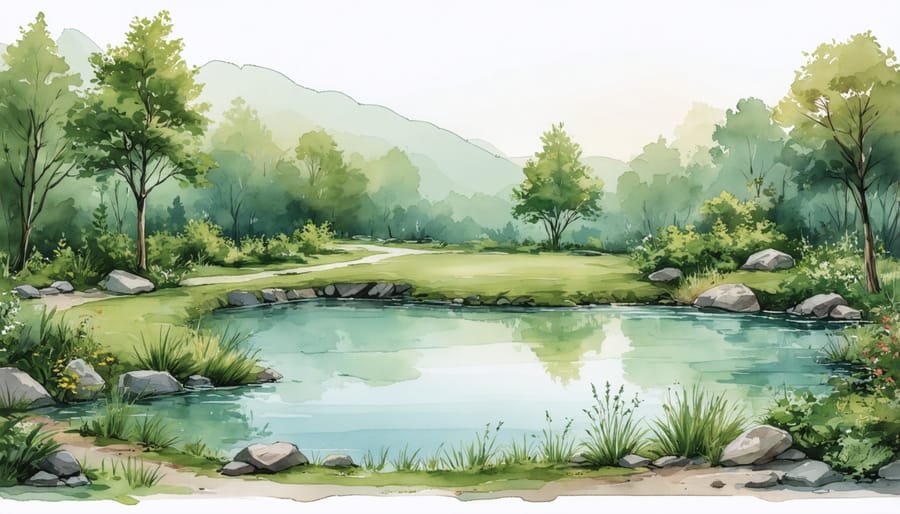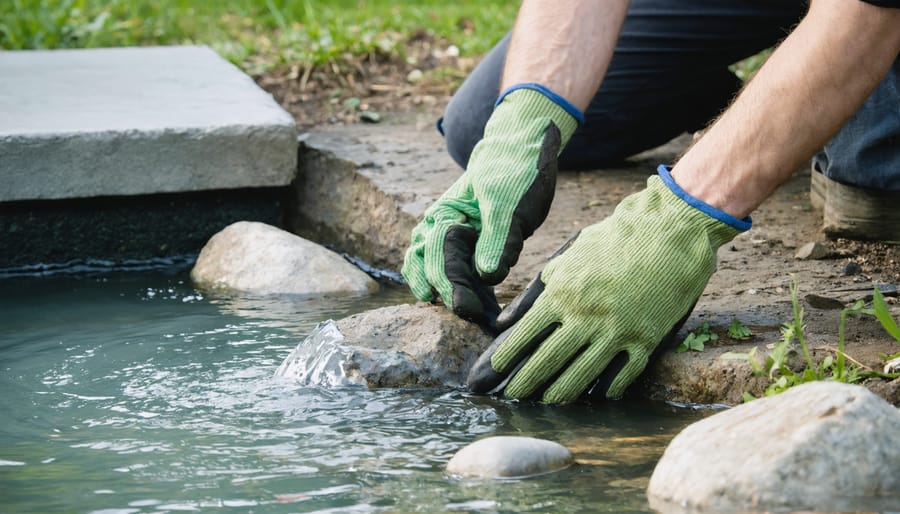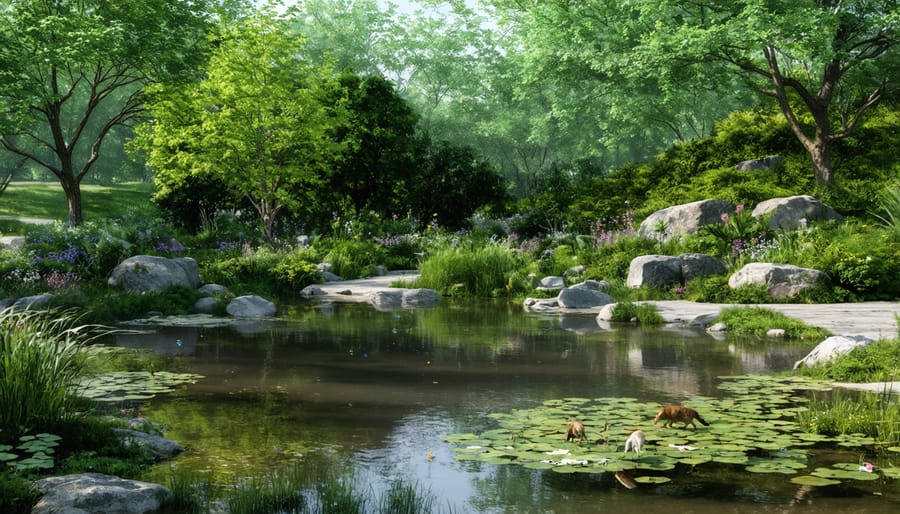
6 Steps to Create a Thriving Wildlife Pond in Your Backyard
Transform your garden into a thriving oasis for local wildlife by constructing a natural pond. Carefully select a location that receives partial sun and shade, ensuring it blends seamlessly with the surrounding wildlife habitats. Excavate the pond area, creating gentle slopes and varying depths to accommodate diverse plant and animal species. Line the pond with a durable, flexible liner, and cover the edges with rocks, gravel, and native vegetation to create a natural, inviting aesthetic. Fill the pond with clean water, introduce native aquatic plants, and let nature take its course as the ecosystem establishes itself. With patience and minimal intervention, your wildlife pond will soon buzz with activity, attracting a vibrant array of birds, amphibians, insects, and small mammals to your backyard sanctuary.
Planning Your Wildlife Pond

Choosing the Right Location
When choosing the perfect spot for your wildlife pond, consider a location that receives a good balance of sunlight and shade. Ideally, the pond should get around 4-6 hours of direct sunlight daily to support aquatic plant growth. Avoid heavily shaded areas, as they can hinder plant development and lead to stagnant water.
Proximity to a clean water source is also important for maintaining pond health. Rainwater is the best option, so consider placing your pond near a downspout or in an area that naturally collects runoff. If using tap water, let it sit for a few days to allow chemicals like chlorine to dissipate.
Finally, think about the viewing experience. Position the pond where it can be easily seen and enjoyed from your favorite outdoor spaces, such as a patio or deck. This way, you can fully appreciate the diverse wildlife your pond attracts and the natural beauty it adds to your garden.
Determining the Size and Depth
When determining the size and depth of your wildlife pond, consider the space available in your garden and the features you want to include. A larger pond will accommodate more wildlife and aquatic plants, but even a small pond can attract a variety of species. Aim for a minimum surface area of 4-5 square meters (43-54 square feet) to create a stable ecosystem. If space allows, a pond of 20 square meters (215 square feet) or more is ideal for supporting a diverse range of wildlife.
The depth of your pond will depend on the types of wildlife you want to attract. A shallow area with a depth of 5-20 cm (2-8 inches) is perfect for marginal plants and will attract birds, insects, and amphibians. Deeper areas of 60-90 cm (24-36 inches) will provide shelter for aquatic creatures during winter. If you plan to keep fish, include a section at least 120 cm (48 inches) deep.
Designing the Pond Surroundings
To create a naturalized pond that blends seamlessly with the landscape, carefully design the surrounding edges. Use rocks, logs, and native vegetation to soften the transition between water and land. Arrange stones and driftwood along the shoreline to provide basking spots for wildlife and create visual interest. Plant a diverse mix of native marginal plants, grasses, and shrubs to establish a lush, natural-looking border. This vegetation not only enhances the pond’s aesthetic appeal but also creates essential microclimates and habitats for various species. By thoughtfully designing the pond surroundings, you’ll craft an inviting oasis that attracts and supports local wildlife.
Gathering Materials and Equipment
To create your wildlife pond, you’ll need to gather some essential materials and equipment. Start with a durable pond liner to hold the water, along with an underlay to protect it from punctures. Depending on the size of your pond, choose a liner with sufficient dimensions. You may opt for a preformed plastic liner or a flexible butyl rubber one.
Next, consider whether you want to include any water features like fountains, waterfalls, or streams. These will require pumps to circulate the water. Submersible pumps are a popular choice for small to medium ponds. To maintain water clarity, you might also want to install filters to remove debris and excess nutrients.
For a natural look, gather rocks, pebbles, and boulders to line the edges and create shallow areas. Aquatic plants are essential for a thriving ecosystem, so choose a mix of marginal, submerged, and floating species native to your area. You may need planting baskets, soil, and gravel to establish the plants.
Other useful tools include a spirit level for ensuring even edges, a spade or excavator for digging, and a hose or water source for filling the pond. With these supplies ready, you’ll be well-equipped to start building your wildlife oasis.
Excavating and Lining the Pond
Marking and Excavating the Pond Area
To mark the pond area, use a garden hose or rope to outline the desired shape on the ground. Consider the pond’s location, size, and how it will blend with the surrounding landscape. Once satisfied with the outline, use spray paint or flour to create a more permanent mark.
When excavating, start by removing the top layer of grass or vegetation. Then, dig out the pond area to the desired depth, typically between 60-90 cm (2-3 feet) for a wildlife pond. Create tiered levels or shelves along the pond’s edges at various depths to accommodate different plant species. These shelves should be about 20-30 cm (8-12 inches) wide and at depths of 10-15 cm (4-6 inches), 20-40 cm (8-16 inches), and 60-80 cm (24-32 inches) to provide diverse habitats for plants and wildlife.
As you dig, set aside the excavated soil for later use in landscaping around the pond. Remember to create a gentle slope on one side of the pond to allow easy access for wildlife.
Installing Underlay and Liner
Carefully spread a protective underlay material, such as old carpet, sand, or a commercial underlay product, across the excavated pond area. This layer helps prevent punctures in the liner from sharp stones or roots. Next, unfold the pond liner and gently place it over the hole, allowing plenty of excess material around the edges.
Avoid stretching the liner too tightly, as it needs some slack to conform to the contours of the pond. Weigh down the edges with heavy objects like bricks or rocks to keep the liner in place. Carefully smooth out any wrinkles or folds, working from the center outwards.
To prevent future punctures, consider adding a layer of sand or soft soil on top of the liner before filling the pond with water. This extra cushioning helps protect the liner from any sharp debris that may fall into the pond over time. With the underlay and liner properly installed, your wildlife pond is ready for the next steps in creating a thriving aquatic habitat.
Securing and Disguising Pond Edges
To secure the pond liner, dig a trench around the perimeter, lay the liner inside, and backfill with soil. For a natural look, disguise the edges by arranging rocks, boulders, and gravel. Create planting shelves by stacking flat stones, providing space for marginal plants. Alternatively, fold the liner to form pockets, fill with soil, and plant directly. Soften harsh lines with ground cover plants trailing over the edges. Driftwood and logs can also artfully conceal the liner. Experiment with different materials and configurations until you achieve the desired aesthetic, ensuring a seamless transition from pond to surrounding landscape.

Adding Water, Plants, and Wildlife

Filling the Pond and Installing Equipment
Once your pond basin is ready, it’s time to fill it with water. For larger ponds, a garden hose is the simplest option. As the pond fills, monitor the liner for any leaks or wrinkles that need adjusting. When the pond is full, let the water settle for a few days before installing equipment. For filtration, choose a pump and filter system sized appropriately for your pond volume. Position the pump at the deepest point and disguise it with rocks or plants. You can also add features like fountains or waterfalls for visual interest and aeration. With equipment in place, your wildlife pond is nearly complete!
Choosing and Planting Aquatic Flora
When selecting plants for your wildlife pond, opt for native aquatic species that naturally thrive in your local environment. Native aquatic plants are well-adapted to the climate and provide food, shelter, and oxygenation for pond inhabitants. Consider a mix of submerged plants like hornwort and water milfoil, floating plants such as water lilies and frogbit, and marginal plants including rushes and sedges.
Before planting, rinse the roots to remove any soil and place them in aquatic planting baskets filled with gravel or clay-based aquatic compost. Submerged plants can be weighted down and placed directly on the pond bottom. Position marginal plants on shelves or in shallower areas, ensuring the crowns remain above the water surface.
Space plants appropriately to allow for growth and prevent overcrowding. Aim for about 50-60% plant coverage to maintain a healthy balance in the pond ecosystem. Monitor plant growth regularly and remove any excess to avoid nutrient buildup. With the right selection and care, your native aquatic plants will create a thriving and visually appealing habitat for wildlife to enjoy.
Attracting and Introducing Wildlife
To attract wildlife to your new pond, incorporate native aquatic plants around the edges and in shallow areas. Submerged vegetation provides shelter and breeding grounds for amphibians and invertebrates. Floating plants offer shade and resting spots for dragonflies and frogs. Marginal plants along the banks create habitats for birds and insects. Avoid introducing fish initially, as they may disrupt the delicate ecosystem balance. If you choose to add fish later, select native species that won’t overcrowd or outcompete other pond inhabitants. By designing your pond with diverse plant life and natural elements, you’ll create an inviting sanctuary for local wildlife to thrive.
Maintaining Your Wildlife Pond
Once your wildlife pond is established, some regular maintenance will keep it healthy and thriving. Upkeep tasks are generally minimal, as a well-designed pond largely takes care of itself.
Maintaining good water quality is crucial. Monitor pH levels and adjust if needed using pond-safe products. Remove excessive fallen leaves and debris to prevent nutrient buildup that can fuel algae growth. Occasional partial water changes can refresh the pond.
Algae is a natural part of the ecosystem, but unchecked blooms can be unsightly. Manual removal with a net or rake is often sufficient. Barley straw can help inhibit algae growth. Avoid harsh chemicals that may harm pond life. Establishing a balance of plants that compete with algae for nutrients is key.
Caring for pond plants involves occasional pruning of vigorous growers and removing dead foliage. Divide and repot water plants as needed to control their spread. Marginal plants may require cutting back in late fall.
For wildlife, little intervention is necessary. Avoid disturbing habitats during breeding seasons. Provide additional food sources if needed, but let nature largely take its course.
Inspect the pond regularly for any signs of damage or leaks, and address promptly. Maintain pumps and filters per manufacturer guidelines. In harsh winter climates, some preparation may be needed to protect pipes from freezing.
With a bit of TLC, your wildlife pond will reward you with years of natural beauty and thriving ecosystems. Embrace the ever-changing tapestry and marvel at the diversity of life your haven supports.
Conclusion
In conclusion, creating a wildlife pond in your backyard is a rewarding journey that enriches both your outdoor space and the local ecosystem. By following the key steps outlined in this article, from careful planning and site preparation to planting and ongoing maintenance, you can transform a simple garden feature into a thriving oasis for diverse wildlife. As you watch your pond come to life with the sights and sounds of nature, you’ll experience the joy and satisfaction of providing a valuable habitat for countless species. We encourage you to explore more pond ideas, experiment with different designs, and share your experiences with fellow water gardening enthusiasts. Remember, every wildlife pond, no matter its size or style, makes a positive impact on our environment and brings a piece of wild beauty into your daily life.
